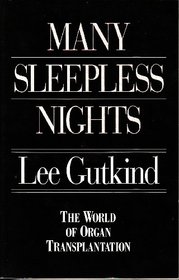Helpful Score: 2
Written in 1988, this book provides insight into the rise of organ transplants. Even today, transplants are relatively rare, but in 1988 many doctors were still working out how to do some of them. Of course they are always trying to find better ways, better outcomes, but in 1988 some transplants were only done in a few locations in the world.
This book features two hospitals in particular: Stanford and Pittsburgh (Presbyterian-University Hospital). However, Gutkind spent time in a number of transplant hospitals around the world to gather information about techniques, doctors, staff, and patients.
The book gives us a brief history of some historic transplants ( including the first heart transplant and Baby Fae, the baboon heart into an infant), then moves into the current state of the art and where transplant doctors and support people were moving then. Actual patients are introduced and then followed in later chapters.
A few things I learned:
* Transplant surgeons are a breed of their own. It takes special training to do this work, both in the surgical removal of organs from a brain-dead donor and in the surgical implantation of the organs into the recipients. Certain doctors have developed techniques and explored immune-suppressant drugs and have changed the course of transplant methods.
* There are support staff who do the work of finding organs and choosing suitable potential recipients, and who even travel with the transplant team to coordinate the removal of organs and return to the recipient's hospital. These hardworking souls have been on call 24/7 to work with patients, doctors, and hospitals, coordinating the whole transfer.
* Because of the scarcity of organs, only the sickest usually get the organ(s). And once transplanted, if that organ goes bad the recipient is still first on the list for the next (once transplanted they take priority; the surgeons are committed). Many transplants fail, and in some cases a single person can receive three or more of the same organ over time.
* Life after transplants is like life with a chronic disease. The patient has to keep taking immunosuppressant drugs and must avoid exposure to infection. Failure can occur at any time. There are many side effects that have to be managed. It is life on the edge and often is a life of misery.
In this history-biographical book, the donors are already dead. There is little mention of living donors, except early on, where it is noted that doctors take it particularly hard when a living donor dies or has other tragic responses to her surgery. It is one thing to lose the patient needing the organ; altogether different to lose the donor.
The book provides good information about those involved in the early ground breaking transplants and in the surgical centers that specialize in transplants. At times I found the organization of the chapters a little mysterious and would have liked more continuous coverage of the patients, but by the end I was generally satisfied.
This book features two hospitals in particular: Stanford and Pittsburgh (Presbyterian-University Hospital). However, Gutkind spent time in a number of transplant hospitals around the world to gather information about techniques, doctors, staff, and patients.
The book gives us a brief history of some historic transplants ( including the first heart transplant and Baby Fae, the baboon heart into an infant), then moves into the current state of the art and where transplant doctors and support people were moving then. Actual patients are introduced and then followed in later chapters.
A few things I learned:
* Transplant surgeons are a breed of their own. It takes special training to do this work, both in the surgical removal of organs from a brain-dead donor and in the surgical implantation of the organs into the recipients. Certain doctors have developed techniques and explored immune-suppressant drugs and have changed the course of transplant methods.
* There are support staff who do the work of finding organs and choosing suitable potential recipients, and who even travel with the transplant team to coordinate the removal of organs and return to the recipient's hospital. These hardworking souls have been on call 24/7 to work with patients, doctors, and hospitals, coordinating the whole transfer.
* Because of the scarcity of organs, only the sickest usually get the organ(s). And once transplanted, if that organ goes bad the recipient is still first on the list for the next (once transplanted they take priority; the surgeons are committed). Many transplants fail, and in some cases a single person can receive three or more of the same organ over time.
* Life after transplants is like life with a chronic disease. The patient has to keep taking immunosuppressant drugs and must avoid exposure to infection. Failure can occur at any time. There are many side effects that have to be managed. It is life on the edge and often is a life of misery.
In this history-biographical book, the donors are already dead. There is little mention of living donors, except early on, where it is noted that doctors take it particularly hard when a living donor dies or has other tragic responses to her surgery. It is one thing to lose the patient needing the organ; altogether different to lose the donor.
The book provides good information about those involved in the early ground breaking transplants and in the surgical centers that specialize in transplants. At times I found the organization of the chapters a little mysterious and would have liked more continuous coverage of the patients, but by the end I was generally satisfied.




